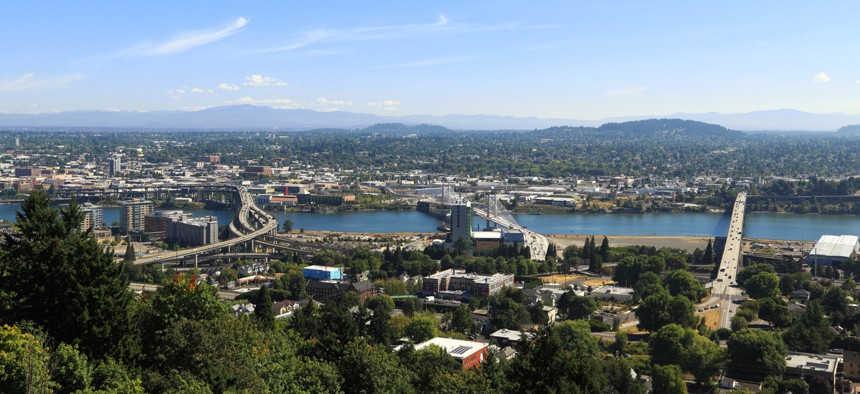Low-Income Communities in This City are More at Risk for Disasters

Neighborhoods in East Portland are more likely to flood. Eduardo Ramirez Sanchez/Shutterstock
As Portland, Oregon considers ways to mitigate environmental risks for poorer neighborhoods, a simple answer is arising: trees.
Lush greenery is synonymous with the Pacific Northwest, especially in Portland, recognized as one of this country’s top ten cities for trees. But new research shows that the landscape outside front doors is not the same for all residents.
Heejun Chang is a geography professor at Portland State University and one of the authors of a new study that found low-income neighborhoods in East Portland to be more susceptible to extreme heat spikes and flooding than wealthier areas of the city.
The study found that class-based segregation and redlining policies likely led to the disparate impact of environmental risks across the city. With housing costs on the rise in this Oregon city, low-income people, immigrants, and people of color have been pushed to the edges of the city, where there are more highways, fewer trees, and less vegetation. With less tree coverage and more concrete, summer brings more intense greater heat spikes, and year round rainfall builds up more quickly with greater potential for flooding.
“When we looked at both urban heat and topographic wetness indices for different areas of the city, we found that neighborhoods with vulnerable populations were consistently exposed to both flooding and heat spikes,” Chang said. “These areas are filled with people who are less affluent and less educated, who have often been pushed out of central Portland by gentrification.”
Last year, the Portland Department of Parks and Recreation mapped more than 234,000 trees in the city, finding their distribution uneven and directly correlated to income. The agency’s report noted that communities of color and low-income residents face significant barriers to tree planting, and recommended planting programs focused on rental properties and increased funding for planting and maintenance in low-income areas—suggestions that will soon be under review with the Portland City Council.

Shawn Fleek, who works for OPAL, a Portland environmental justice organization, noted that East Portland has half the tree canopy recommended by the U.S. Forestry Service, and an overabundance of heavily paved areas. “In neighborhoods that are boxed in by major transportation corridors, the heat gets absorbed. You see infants and elderly folks put at risk, everyone is inhaling more air toxins, asthma is more frequent, and low birth weights happen more often.”
Commissioner Jo Ann Hardesty, of the Portland City Council and herself an East Portland resident, has seen the impact of extreme heat and flooding firsthand. “I believe we have a responsibility to ensure that low-income communities and communities of color are leading our efforts to address the impacts of climate change and to create healthy communities.”
Hardesty championed the Portland Clean Energy fund initiative in late 2018, which supports regenerative agriculture projects, including activities like tree planting, with priority given to low-income neighborhoods.
A bill in the Oregon legislature could eventually lead to residents from different socioeconomic groups being more evenly distributed throughout the city by changing the zoning laws to allow duplexes, triplexes, and quadplexes in areas that are currently only zoned for single family homes.
But Commissioner Hardesty is focused on addressing this at the city level, with the Residential Infill Project, which would similarly put more housing units in residential neighborhoods. As the city moves forward, she said one concern is making sure current residents are able to stay.
“What I’m mostly concerned with is ensuring that any city policy involving rezoning to allow for more density has a strong anti-displacement plan in place. Any policy that doesn’t have anti-displacement plans would open low-income residents and people of color to displacement to the outskirts of the city, where dangers like heat spikes are more likely,” Hardesty noted.
Providence, Rhode Island, which similarly found disparities in tree coverage along socioeconomic lines, is also concerned with so called “green gentrification,” wherein a city’s efforts to improve the vegetation in a neighborhood brings in a rush of new, affluent residents.
Leah Bamberger, the director of sustainability for Providence, says that building relationships and including the community in efforts like street tree planting is key. “We’re making sure that as we invest in and improve historically disenfranchised neighborhoods, we are doing all we can to avoid displacement, so that the people we’re doing this for can enjoy their community. We are building leadership capacity amongst residents to ensure all efforts are culturally relevant and sustainable,” she said.
Providence and Portland are not alone in trying to find culturally relevant ways to educate people about urban nature. In a recent op-ed, Detroit City Councilmember Scott Benson bluntly stated “Earth Day doesn’t resonate with low income residents” because the day conjures up “images of those with the luxury of spare time and disposable income to replant trees near the local private school,” an experience that doesn’t reflect reality for people in low-income neighborhoods.
But Chang is optimistic that Portland will make more of an effort to reach out to residents in these communities, and suggests the city might start with the next generation. “We could actually do a lot to teach children, and then have them teach their parents about environmental risks and the way trees can help.”
Emma Coleman is the assistant editor for Route Fifty.
NEXT STORY: Virginia Prepares for the Arrival of Amazon’s HQ2






